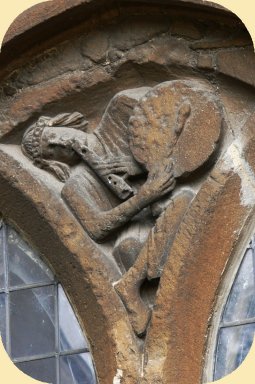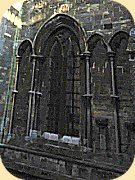pipe and tabor players as
architectural features in the UK
St. Mary the Virgin, Higham Ferrers, Northamptonshire
stone carving
 photo copyright: http://professor-moriarty.com |
The pipe and tabor carving is on the outside of the church tower at ground level. The present church was founded by the charter of Henry III in about 1220, with the tower completed in about 1250. Whilst a large proportion of the original church survives to the present there is some Victorian restoration.
A description in 1915 states:
"Pipe and tabor player carved in the spandrel of a two-storey height window in the tower of St. Mary the Virgin at Higham Ferrers, Northants. The performer is painfully contorted to fit the available space. In reality the performer always stood.
The pipe and tabor were instruments of but small repute musically, chiefly used by strolling minstrels to accompany rustic dancing, tumbling, and other revelries.
The ' snare ' or vibrating cord usually stretched across the parchment of one head and is indicated in the Higham Ferrers example. The pipe used with the tabor was necessarily small to facilitate its manipulation by one hand. It had only three holes, two in front and one for the thumb behind; but being over a foot long there could be produced from it, by means of the harmonics, a scale of more than an octave. "
top of page
